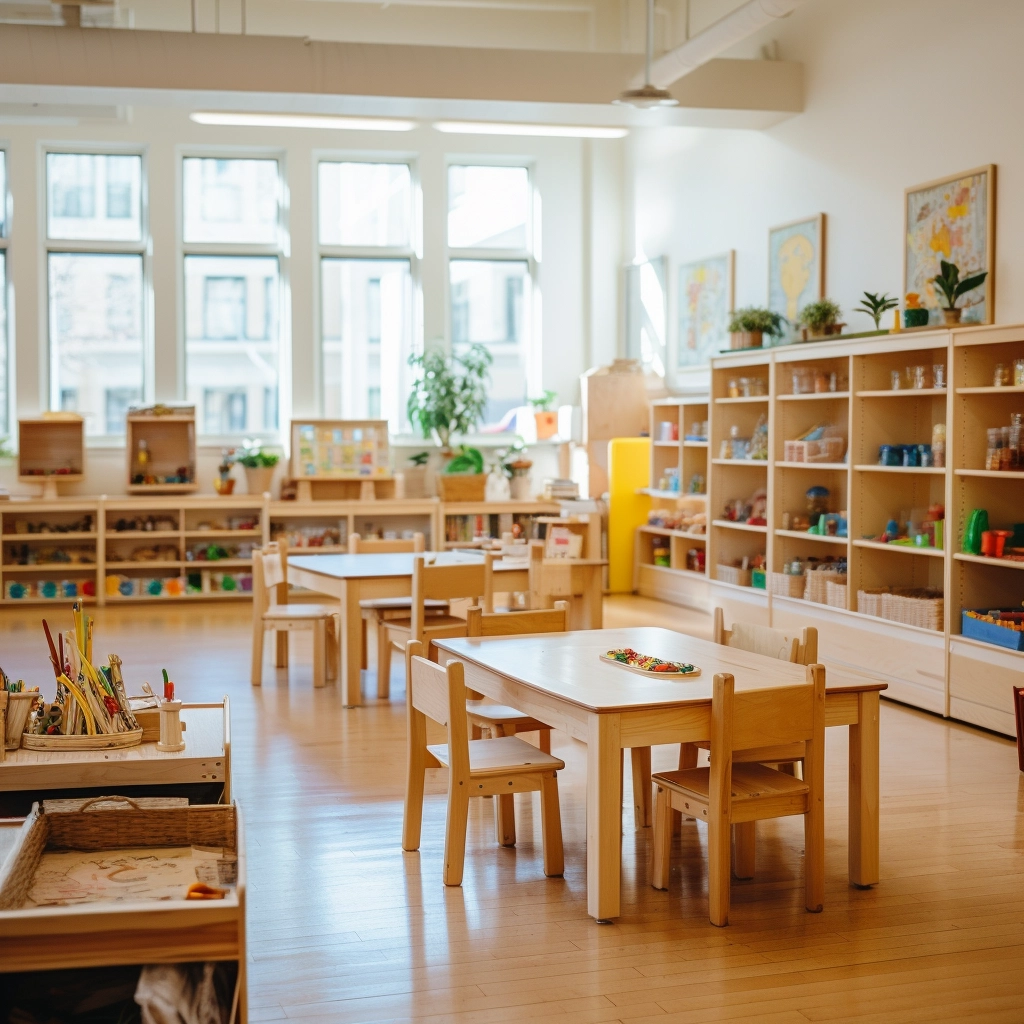Are students in your class frequently distracted, disengaged, or unmotivated? Do your current seating arrangements limit collaboration, stifle creativity, or create behavior challenges? Whether teaching a talkative group of 12 students or organizing a small preschool classroom, poor classroom seating arrangements could silently undermine your efforts. The question is: What kind of desk arrangement truly supports learning, and what setups are leaving students behind?
Classroom seating arrangements directly influence how students learn, interact, and engage. An effective seating plan improves classroom management, encourages participation, and accommodates different learning styles. Whether it’s flexible seating, small group clusters, or U-shaped layouts, the right classroom arrangement fosters focus, collaboration, and a stronger sense of classroom community. It’s not just about placing desks; it’s about designing a learning environment where every seat supports success.
This article will explore 11 innovative classroom seating arrangements that boost engagement and bring learning to life.
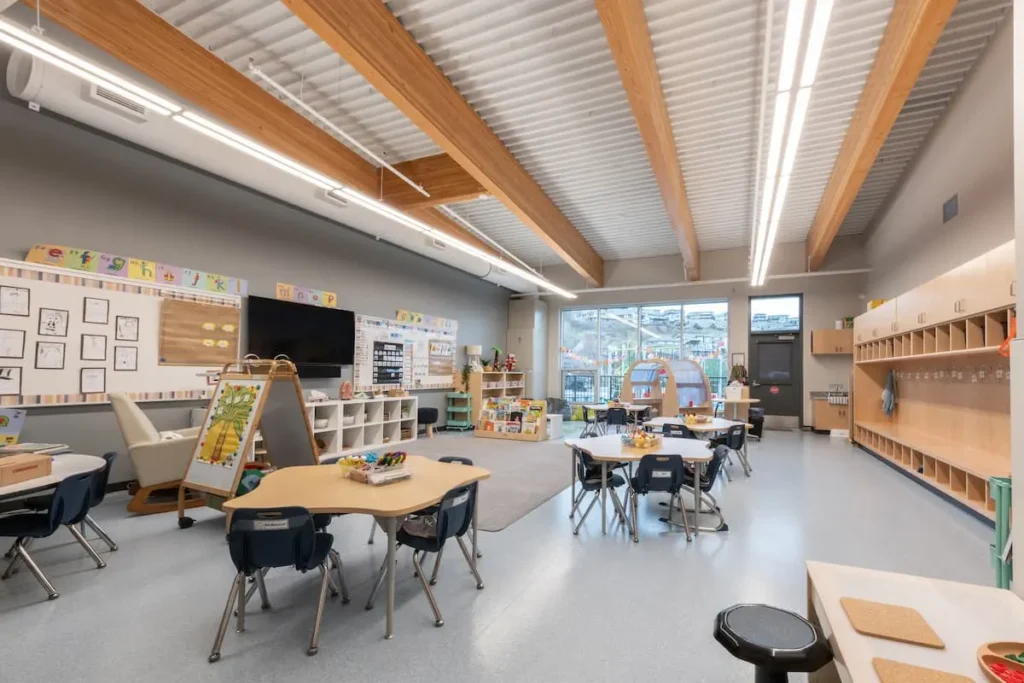
How Does Seating Arrangement Affect Learning?
Recent educational psychology and cognitive neuroscience studies have shown that how students sit in a classroom significantly shapes their learning, communication, and performance. Research from the University of Salford (UK) found that classroom layout, especially seating proximity, desk orientation, and lighting, can influence academic progress by up to 25%. Another study published in Learning Environments Research highlights that flexible and well-designed classroom seating arrangements increase student autonomy, motivation, and group interaction.
These findings underscore a crucial point: seating is not just about physical space but learning conditions. When students are seated in a way that aligns with the cognitive demands of a lesson, whether it’s collaboration, reflection, or hands-on activities, they are more likely to stay engaged, process information more effectively, and participate confidently. In contrast, poorly thought-out seating setups can contribute to disengagement, social isolation, and behavioral challenges.
Educators today are rethinking traditional layouts and opting for dynamic, student-centered seating arrangements that support various learning styles. The best arrangements are intentional, whether through semicircular group tables for discussions, modular desks for quick rearrangement, or quiet corners for individualized work. They go beyond aesthetics and functionality to create an inclusive environment where every seat becomes a strategic part of the learning process.
Important: Priority Seating for Students with Disabilities
In any discussion about classroom seating arrangements, inclusivity must come first. While many educators focus on boosting collaboration or reducing distractions, adequate seating also means ensuring that every student, especially those with disabilities, has equal access to learning.

Designing inclusive classroom seating arrangements isn’t just a pedagogical choice; it’s a legal and ethical responsibility. Under laws like the Individuals with Disabilities Education Act (IDEA) and Section 504 of the Rehabilitation Act in the United States, schools must provide reasonable accommodations for students with disabilities. One of the most effective accommodations, and often one of the most overlooked, is priority seating.
พร้อมที่จะออกแบบพื้นที่ที่สร้างแรงบันดาลใจในการเรียนรู้หรือยัง ติดต่อเราเพื่อสร้างโซลูชันเฟอร์นิเจอร์ที่ปรับแต่งให้เหมาะกับความต้องการในห้องเรียนของคุณ
Common Classroom Seating Arrangements
1. V-Shape Layout
Also known as the chevron layout, the V-shape desk configuration angles student desks toward a central focal point, typically the whiteboard or teaching area. This layout is handy in rooms with a single instructional direction, such as lecture-heavy environments or multimedia classrooms. By slanting the desks inward, students maintain a direct line of sight to the teacher while gaining partial visibility of their classmates. This setup naturally draws students’ focus to the front, improving attention and reducing side conversations.
The V-shape also makes teacher movement more fluid, allowing easy circulation between desks. However, it may limit group collaboration since students aren’t facing each other directly. Educators using this layout often supplement it with occasional desk rearrangements for group activities. While unsuitable for every age group, this design offers a balanced compromise between structure and visibility.
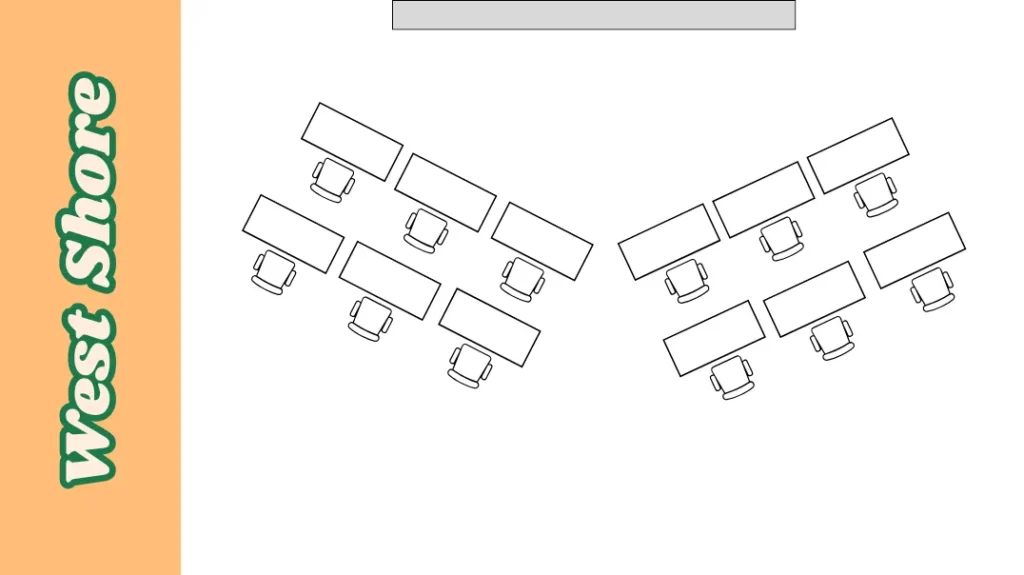
2. U-Shape Layout
The U-shape is a classic classroom seating arrangement emphasizing whole-group interaction and teacher accessibility. Desks are arranged in a three-sided rectangle, leaving an open space in the center where the teacher can easily move and engage with students individually. Because each student faces inward, this format supports class discussions, presentations, and Socratic-style questioning.
The benefits of the U-shape go beyond visibility. It fosters a sense of community by placing all students within each other’s line of sight, promoting inclusivity and active listening. It’s particularly effective in language arts, social studies, and debate settings where dialogue is central to learning. However, this layout does take up more space and may not accommodate larger class sizes without sacrificing accessibility.
While not ideal for group work, it promotes engagement, encourages eye contact, and makes it easier for teachers to monitor behavior and comprehension anywhere in the room.
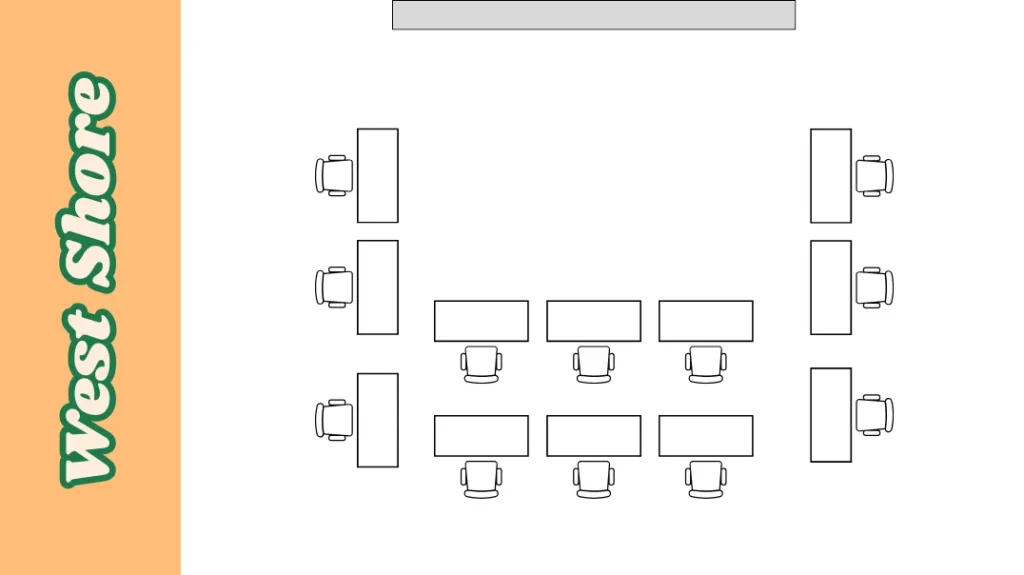
3. Individual Layout
This seating style places students at individual desks spaced evenly across the room, typically all facing forward. It’s one of the most effective classroom setups for minimizing distractions, managing behavior, and encouraging independent work. Often used during assessments or focused tasks, this arrangement reduces peer influence and creates defined personal space.
The individual layout provides a high level of teacher control in classrooms with talkative or easily distracted students. It also supports equitable instruction, as all students receive the same view of the board and teacher. The layout can feel isolating, especially for younger students or in classes where collaboration is essential.
Modern classroom design tools allow teachers to customize this layout to suit social distancing guidelines and learning objectives. Some educators adapt this model by adding temporary pairings or rearranging desks into pods for group activities, striking a balance between structure and flexibility.
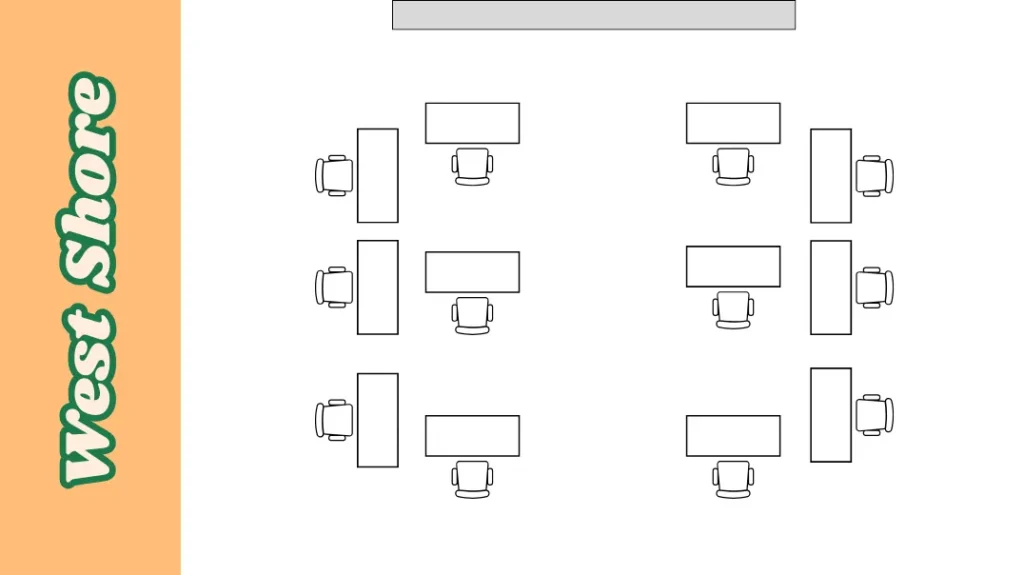
4. Group Islands
Group islands, also known as cluster seating or pod seating, are one of the most popular classroom desk arrangements for promoting collaboration. In this setup, desks are grouped into small “islands” of four to six students facing one another. It creates an intimate learning space where peer-to-peer interaction becomes a natural part of the classroom rhythm.
This arrangement is ideal for cooperative learning strategies like jigsaw activities, group discussions, or project-based learning. It encourages students to share ideas, solve problems, and build communication skills. For younger students, it can support social development; for older students, it reinforces accountability within a team.
However, group islands require strong classroom management. With desks facing each other, there’s a higher risk of off-topic chatter or distraction. Teachers often set clear expectations and roles, like “group leader” or “materials manager,” to maintain focus. Despite these challenges, the format aligns well with modern educational philosophies that value interaction, engagement, and student-centered learning.
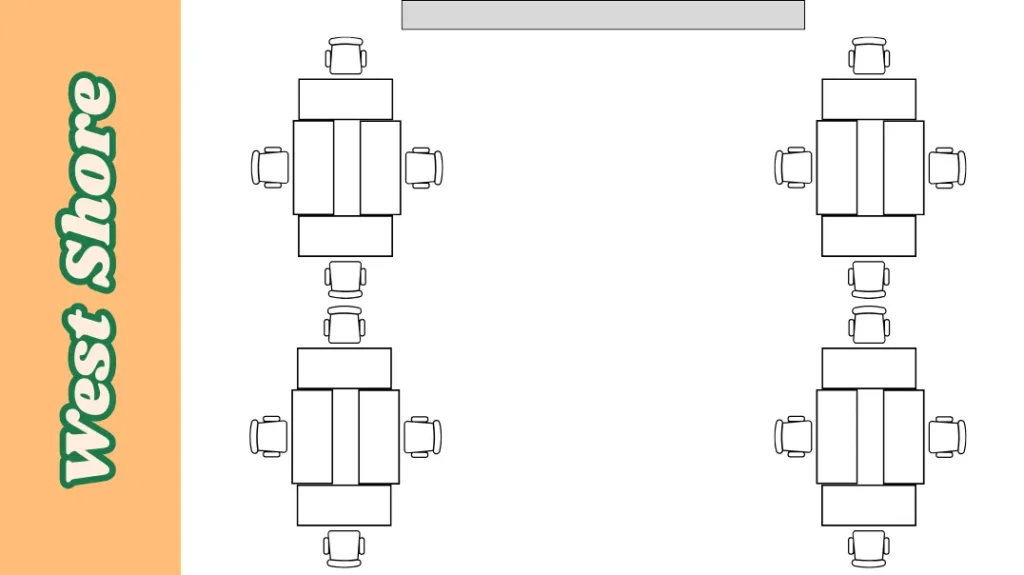
5. Symmetrical Groups
Symmetrical group layouts are a refined version of island seating, emphasizing visual balance and space efficiency. Desks are arranged in even groupings, typically pairs or quads, spread evenly throughout the room. This layout effectively promotes small-group collaboration without overwhelming the classroom with larger, noisier clusters.
Unlike traditional islands, symmetrical groups are often arranged with clear walking paths in mind, allowing teachers to circulate easily and check in on student progress. This is a great option for classrooms where both individual and partner work occur frequently, such as upper elementary and middle school settings. It can also be scaled up or down depending on the subject and activity, making it adaptable.
This layout provides structure while still fostering interpersonal interaction. It supports student seating in a way that balances autonomy with collaboration, offering the best of both worlds in classrooms that value order and creativity.
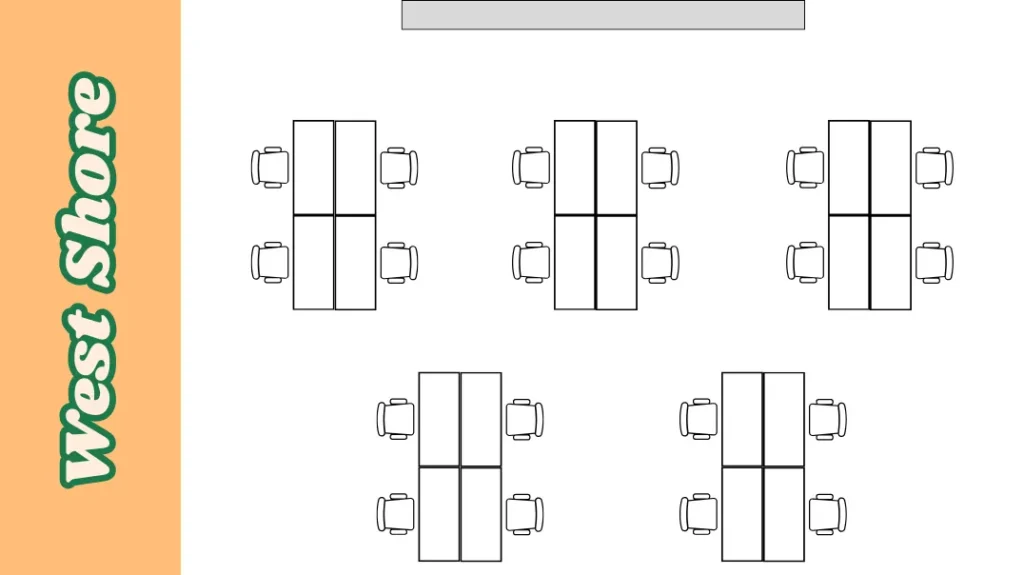
6. Circle Layout
The circle arrangement transforms the classroom into a community forum. All desks or chairs are placed in a full circle, with no front or back of the room. This setup sends a powerful message: every voice matters. It’s widely used in early education for morning meetings, in high school for literature circles, and across grade levels for reflective conversations and sharing sessions.
Circle seating encourages eye contact, equality, and open communication. There’s no hierarchy; students and teachers occupy the same space with equal visibility and opportunity to contribute. For this reason, it’s a powerful format for social-emotional learning (SEL), class discussions, and restorative practices.
One drawback is space; it requires a large, open classroom to work effectively. It’s also not ideal for direct instruction or note-heavy lessons. However, few seating arrangements are as impactful as circle layouts as a tool for building classroom culture. Many educators alternate between circle layouts and more structured setups depending on the day’s objectives.
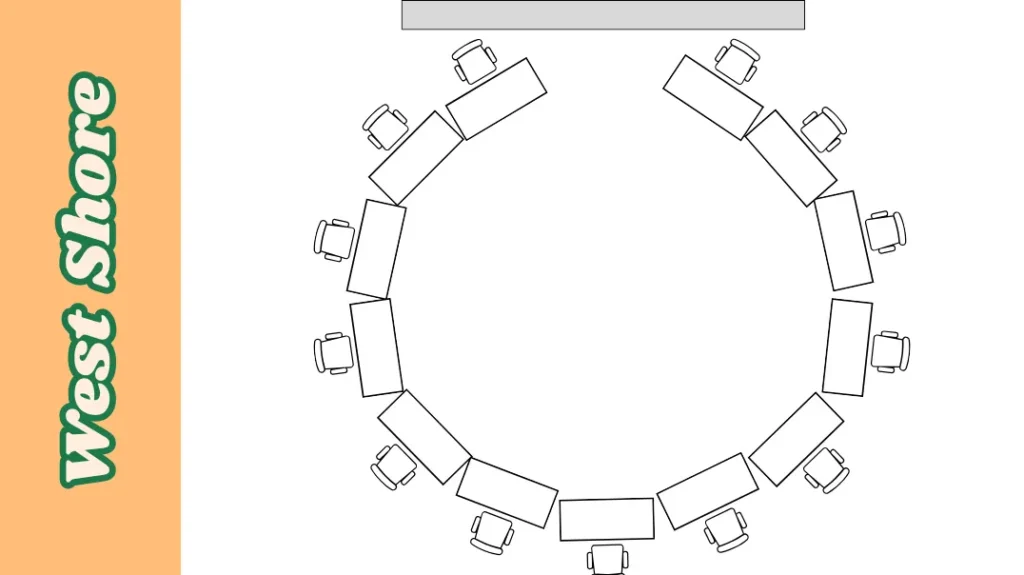
7. Quadrant Grouping
Quadrant grouping divides the classroom into four distinct zones, each functioning as a self-contained learning area. Desks within each quadrant are arranged in tight clusters, similar to group islands, but the room is sectioned so each group feels like a semi-independent unit. This layout is particularly effective in classrooms using station-based learning, rotational models, or thematic group work.
This setup helps reduce noise and visual distractions while still promoting interaction within each quadrant by separating students into spatial zones. Teachers can assign roles, rotate materials between zones, or even theme each quadrant according to a different subject area or task. It’s also beneficial for differentiated instruction, allowing educators to tailor activities based on ability or learning preference.
Quadrant grouping supports structure and flexibility, blending the benefits of collaborative seating with clear physical boundaries. It’s a strong choice for upper elementary through middle school classrooms where group identity and independent responsibility are essential elements of the learning culture.
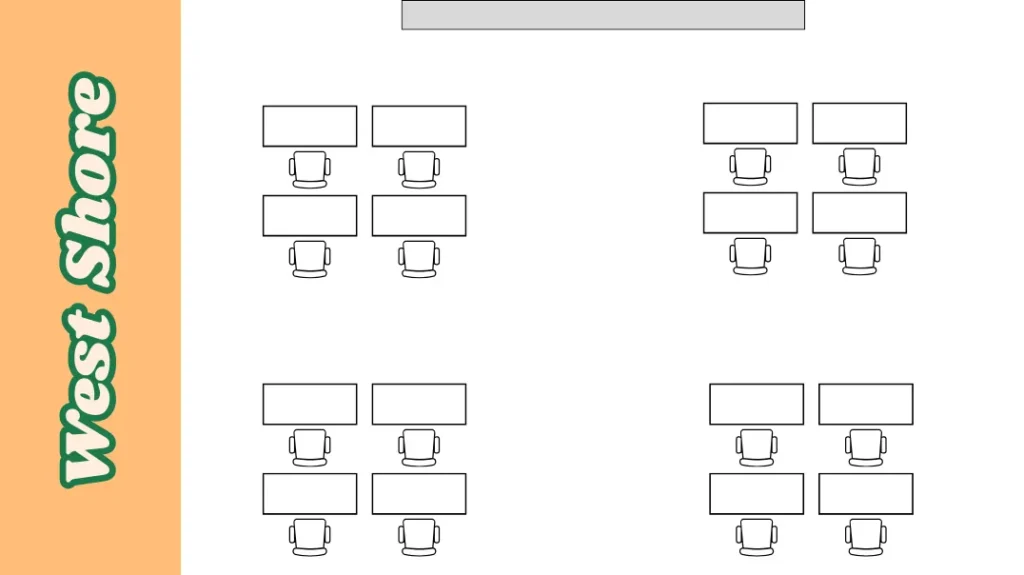
8. Conference Layout
Modeled after a corporate meeting room, the conference layout uses desks or tables arranged in a square or hollow rectangle, allowing students to face one another across a shared space. This classroom desk arrangement encourages formal discussion, peer critique, and high-level dialogue, making it especially useful in secondary and higher education settings.
In this setup, the teacher often facilitates from the perimeter rather than the front of the room, shifting the classroom dynamic toward student leadership. It’s perfect for literature discussions, project pitches, or Socratic seminars where face-to-face communication is essential. The open central area can also serve as a presentation zone, allowing individual students or groups to take center stage when needed.
However, space constraints may limit its use in smaller classrooms. While it promotes communication, it’s less suited for large-scale collaborative work or kinetic activities. Still, when used strategically, the conference layout reinforces professionalism and academic rigor, ideal for preparing students for real-world communication scenarios.
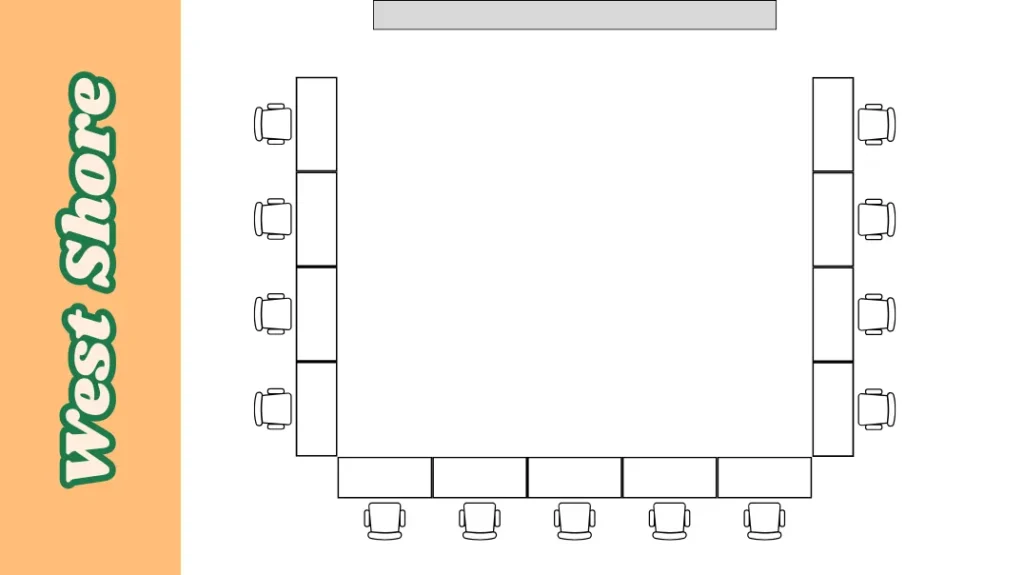
9. Double Row Layout
A staple in traditional classrooms, the double-row layout features desks aligned in two horizontal lines, typically all facing forward. Its strength lies in its simplicity; it is easy to set up, maintain, and manage. It remains a practical option in classrooms where direct instruction, lecture-based content, or board work are primary delivery methods.
This seating style provides every student with a clear view of the front of the room and minimizes distractions by reducing face-to-face interaction. Teachers benefit from predictable circulation paths and the ability to monitor behavior from a single vantage point. It’s also ideal for environments prioritizing quiet, focused work, such as during exams or writing sessions.
That said, it doesn’t foster collaboration as naturally as other arrangements. Teachers using this layout often integrate turn-and-talk strategies or temporary pairing activities to encourage peer interaction. The double row format remains a reliable classic for classrooms seeking order, clarity, and ease of implementation.

10. Double Long Tables (Banquet Style)
The banquet-style arrangement transforms traditional desks into long, communal tables with students seated on both sides. These “dining-hall” inspired setups are ideal for project-based learning, cooperative assignments, and hands-on group activities. By joining individual desks into continuous rows, this layout fosters a strong sense of community and encourages constant peer interaction.
Teachers benefit from easy monitoring; they can walk between the tables and observe group dynamics or provide support where needed. This format is especially effective in art, STEM, and early education environments where materials are shared, and students must collaborate frequently.
However, managing focus can be a challenge. The proximity between students increases the likelihood of off-task behavior, especially in larger classes or among younger learners. This setup often involves structured roles, time-based rotations, or clear behavioral expectations. For classrooms looking to combine interaction, space efficiency, and creativity, the banquet layout offers an energetic and social learning environment that breaks away from the rigidity of traditional rows.
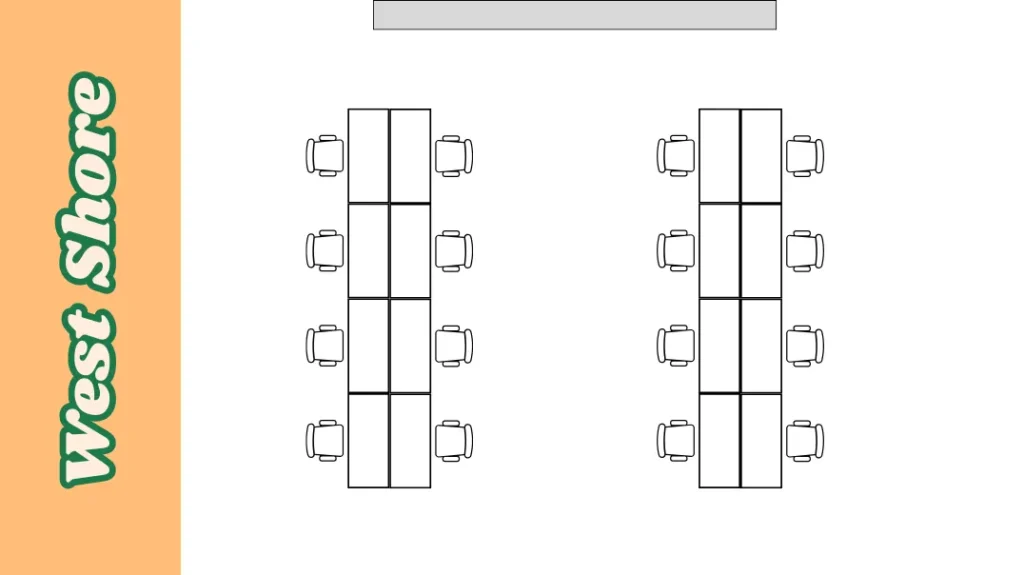
11. Grid Rows (Traditional Exam Style)
The grid row layout, often referred to as the traditional or exam-style setup, places individual desks in evenly spaced rows and columns, all facing forward. This configuration maximizes classroom capacity while minimizing distractions, making it a go-to choice for high-stakes testing, focused instruction, or environments that demand quiet, independent work.
Each student has their own defined space, which helps reinforce personal responsibility and reduce opportunities for off-task behavior. From a classroom management perspective, it provides clear sightlines and walkways, allowing teachers to maintain control and ensure every student is on task.
While this layout is less conducive to discussion or collaboration, it excels in settings where structure and clarity are top priorities. It’s commonly used in middle school and high school classrooms, especially in subjects like math, science, or standardized testing scenarios. Some educators incorporate this layout into a flexible seating plan, rotating between exam rows and more interactive formats depending on the day’s objectives.
Though traditional, the grid format remains an essential tool in a teacher’s layout toolkit, ideal for creating a focused, disciplined learning atmosphere where every student has a space.
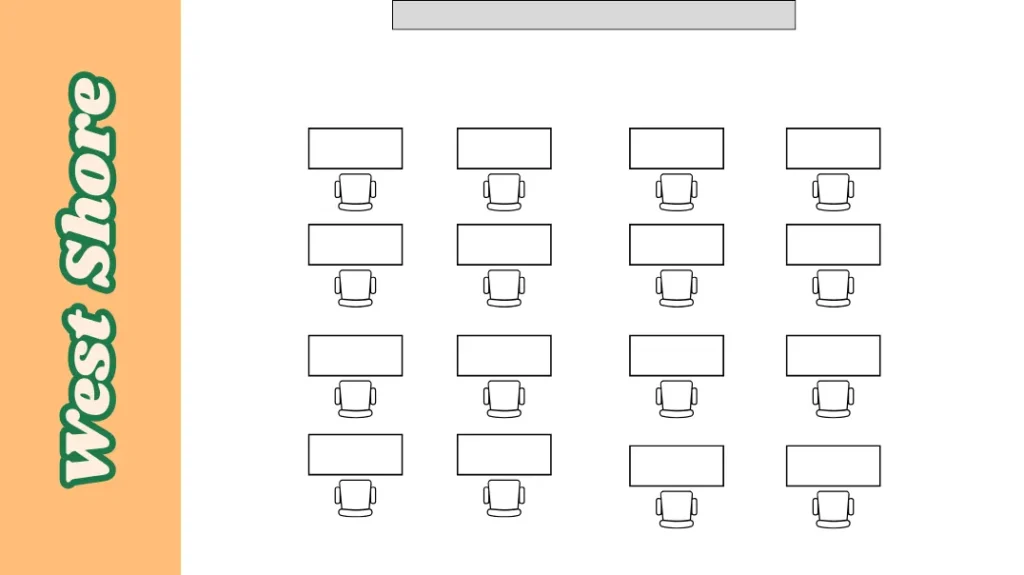
Considerations for Choosing a Seating Arrangement
Choosing the right classroom seating arrangement is more than just placing desks in a pattern; it’s a strategic decision that impacts engagement, inclusion, and instructional success. While specific layouts may look appealing or seem adequate in theory, every classroom is unique, and what works for one may not work for another. To build a seating plan that truly supports learning, educators must weigh several key considerations before making a final decision.
Align with Instructional Goals
Your seating arrangement should reflect your teaching style and lesson objectives. Forward-facing layouts, such as grid rows or V-shaped configurations, ensure visibility and order for direct instruction and content delivery. Collaborative formats, like group islands or quadrant groupings, may be more appropriate if your pedagogy leans toward inquiry-based learning or group projects. Consider how students engage with content, individually, in pairs, or as a class, and choose a structure that makes that interaction seamless.
Promote Meaningful Student Interaction
One of the most overlooked elements in seating design is how it affects peer interaction. Arrangements like U-shapes, circles, or symmetrical groupings foster open dialogue and active listening. In contrast, traditional rows often limit communication, which can be helpful for focused work but detrimental to the classroom community. Think about how you want your students to connect: Do you want them to share ideas, debate, or collaborate on tasks? The right desk arrangement can either facilitate or restrict these interactions.
Ensure Accessibility and Equity
Accessibility must be built into your seating plan, not retrofitted afterward. Students with physical disabilities, sensory sensitivities, or specific learning needs may require preferential seating. This could mean access to natural lighting, reduced noise, or proximity to instructional zones. Seating must also allow for precise teacher movement and emergency access. Additionally, inclusive arrangements make room for assistive devices, provide flexible seating options, and ensure that every student can participate equally in the classroom experience regardless of ability.
Adapt to Classroom Size and Spatial Limitations
Even the most innovative layout will fail if it doesn’t fit the room. The number of students, the shape of the space, and available furniture all dictate what’s feasible. In smaller classrooms, circle or conference layouts may feel cramped, while large group tables might consume too much space. Pathways must remain open for walking, and visual access to instructional displays should be preserved. A well-planned setup connects closely with effective การจัดระบบห้องเรียน, balancing movement, comfort, and clarity while avoiding clutter without sacrificing collaboration.
Build in Flexibility for Evolving Needs
No seating plan can serve every purpose, so flexibility is critical. Classrooms are dynamic environments: you may begin the day with a lecture, move into group work, and finish with quiet reading. Choosing movable furniture, lightweight desks, and modular seating allows you to shift layouts throughout the day or year. Some educators involve students in designing and rotating seating charts, building classroom ownership and adaptability into the culture.
Ultimately, adequate seating arrangements are not about perfection but responsiveness. By considering instructional needs, social interaction, accessibility, space, and flexibility, you lay the foundation for a classroom that’s functional and empowering for every student who enters it.

Tips for Effective Seating Arrangements
Designing adequate classroom seating arrangements requires more than simply choosing a layout—it demands ongoing reflection, adaptability, and attention to the evolving needs of your students. Even the most thoughtfully planned layout will require adjustments over time. The following strategies can help you create seating plans that work and grow with your classroom.
Use Seating Charts as Strategic Tools
A seating chart is not just a list; it’s a classroom management strategy. Use it to ensure fairness, support group dynamics, and accommodate learning needs. Preferential seating near the front of the room or by anchor students can help learners who struggle with focus or vision. Rotating seating periodically also prevents social cliques and freshens up classroom energy. Tools like a classroom seating chart generator can make this process easier and more efficient.
Balance Visibility with Interaction
Every student needs a clear view of instructional materials, but they also need opportunities to engage with each other. Arrange seats so no one is isolated or stuck behind others. In layouts like group islands or U-shapes, ensure that all students can see the board and the teacher without having to twist uncomfortably. Likewise, avoid placing students where they’re constantly turning their backs to peers during discussions. A good seating chart design should support both communication and visibility.
Incorporate Flexible Seating Thoughtfully
Flexible seating doesn’t mean letting students sit wherever they want without structure. Instead, it involves offering different types of seating, such as floor cushions, stools, standing desks, and soft chairs, and guiding students on how and when to use them. Clearly defined expectations, visual boundaries, and purposeful design make flexible seating successful. Consider organizing your classroom into zones for quiet work, collaborative space, and discussion areas to match seating types with learning goals.
Observe, Reflect, and Adjust Regularly
The best way to know if a seating arrangement works is to watch your students. Are they engaged? Are transitions smooth? Do certain areas of the room generate more off-task behavior? Take notes during lessons and ask for feedback. Many students will offer surprisingly insightful suggestions about what helps them focus. Don’t hesitate to shift furniture, change groupings, or try new desk arrangements mid-year. A responsive seating strategy shows students that their learning environment is constantly improving.
Student Desks and Chairs That Are Easy to Move
To truly make flexible classroom seating arrangements effective, furniture needs to support adaptability. Student desks and chairs that are lightweight and easy to move allow teachers to reconfigure layouts quickly, whether transitioning from group discussions to independent work or rearranging for different class sizes. At West Shore Furniture, we specialize in designing modular, child-friendly classroom furniture that makes these transitions effortless. Our mobile desks and stackable chairs are built to withstand daily use, allowing educators to create dynamic learning environments.
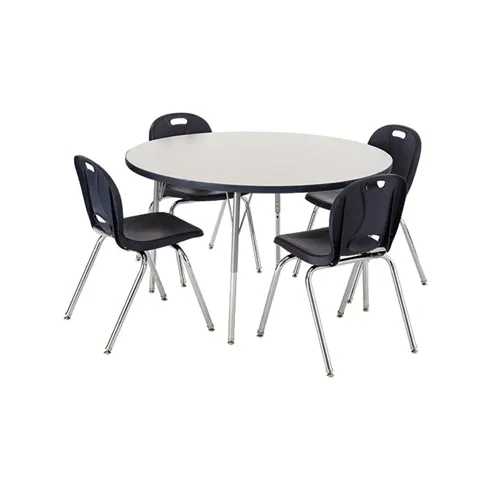
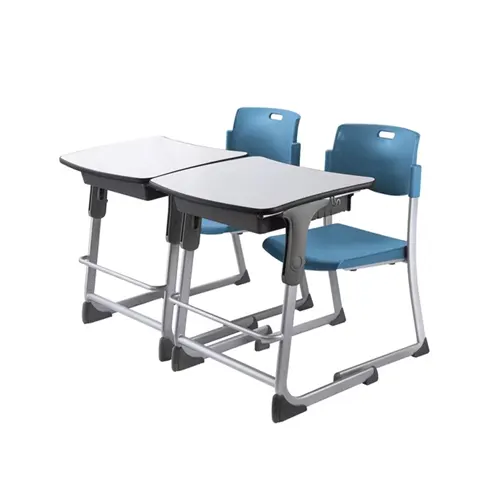
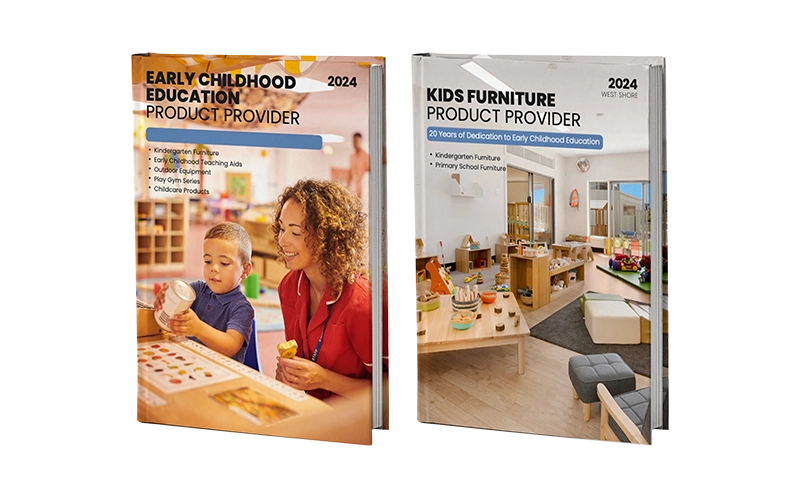
Conclusion: Seating That Shapes Success
Throughout this guide, we’ve explored how intentional classroom seating arrangements can reshape not only the physical structure of a learning space but also the experiences and outcomes of every student within it. From collaborative layouts to focused individual setups, seating acts as a silent yet powerful facilitator of interaction, attention, and accessibility. As education evolves, seating must remain flexible, adapting to shifting teaching methods, classroom sizes, and student needs. The ideal arrangement is not static; it’s strategic, responsive, and grounded in the reality of your learners.
In early childhood environments, especially, the design of seating arrangements must account for developmental needs, safety, and freedom of movement. When these principles are embedded in the furniture itself, through child-sized tables, modular group seating, or soft-edged, moveable desks, the environment becomes a natural extension of teaching. Many educators turn to experienced manufacturers specializing in this age group. Companies like เวสท์ชอร์เฟอร์นิเจอร์, with deep expertise in crafting functional and durable preschool seating solutions, help translate flexible layout strategies into practical, high-quality classroom realities, making it easier for teachers to implement arrangements that inspire growth from the ground up.
Frequently Asked Questions (FAQ)
1. What is the best classroom seating arrangement for student engagement?
There’s no one-size-fits-all solution, but arrangements that promote eye contact and collaboration, like group islands, U-shapes, and semicircle layouts, often lead to higher student engagement. The most effective classroom seating arrangements align with your teaching style, subject matter, and the specific needs of your learners.
2. Which seating arrangement works best for large classrooms?
In larger classrooms, grid rows or double long tables offer structure and maximize space. For group work, quadrant groupings or V-shape layouts provide visibility and flow. In any large classroom seating setup, it’s essential to balance capacity with movement and accessibility.
3. How often should I change my classroom seating arrangement?
It depends on your students and instructional goals. Some teachers rotate seating monthly to refresh dynamics and support equity, while others maintain one layout for consistency. Observing student engagement and classroom flow can help determine when a new seating arrangement is needed.
4. How can seating arrangements support inclusion and accessibility?
Inclusive seating arrangements consider physical access, visual and auditory needs, and student comfort. This may involve preferential seating, clear movement paths, or specialized furniture. Planning with accessibility ensures all students can fully participate in classroom activities.




